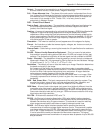
Appendix A • Reference Information
Extron • Matrix 3200/6400 Series • User’s Manual
High Impedance – Hi Z or High Z – In video, when the signal is not terminated locally
and is going to another destination, where it will be terminated. In video, Hi Z is
typically 10k ohms or greater.
Horizontal Rate – Horizontal Frequency – The number of complete horizontal lines,
including trace and retrace, scanned per second. Typically shown as a measure of
kHz.
Horizontal Resolution – Smallest increment of a television picture that can be
discerned in the horizontal plane. This increment is dependent upon the video
bandwidth and is measured in frequency. Determines the number of lines it takes to
scan an image on the screen.
Hue – Tint Control – Red, yellow, blue, etc. are hues of color or types of color. Hue is
the parameter of color that allows us to distinguish between colors.
Hz – Hertz – Frequency in cycles per second.
Impedance – Z – The opposition or “load” to a signal. Circuits that generate audio or
video signals, are designed to work with a certain “load”, or impedance. Typical video
impedances: 75 ohm or High Z. Also see High Impedance and Low Impedance.
Interlaced – The process of scanning whereby the alternate lines of both scanned fields
fall evenly between each other.
IRE Scale – An oscilloscope scale that applies to composite video levels. Typically there
are 140 IRE units in one volt (1 IRE = 7.14 mV).
K – An abbreviation for kilobyte. A kilobyte is 1,000 bytes. In computer memory sizes,
the numbers are rounded down. e.g. 1k byte = 1024 bytes.
Kilohertz – kHz – Thousands of Hertz, or a frequency rate in units of thousands of
cycles per second. For example, CGA’s horizontal scan rate is 15.75 kHz or 15,750
hertz (Hz).
LED – Light-Emitting Diode
Level Control – The Level Control on selected Extron interface products is similar to the
Contrast Control on a data monitor. It can either increase or decrease the output
voltage level of the interface to the connected data monitor or projector. This results
in greater or less contrast in the picture.
Low Impedance – The condition where the source or load is at a lower impedance than
the characteristic impedance of the cable. Low source impedances are common; low
load impedances are usually fault conditions.
Luminance – This is the signal that represents brightness in a video picture. Luminance
is any value between black and white. In mathematical equations, luminance is
abbreviated as “Y”.
M – Mega – An abbreviation for megabyte. A megabyte is 1024K, or roughly a million
bytes (1,048,076 to be exact [1024 x 1024]).
Matrix – In A/V, an electronic device used to collect and distribute video (and sometimes
audio) signals. See matrix switcher.
Matrix switcher – In audio/video, a means of selecting an input source and connecting it
to one or more outputs. A Matrix switcher would normally have multiple inputs and
multiple outputs.
MHz (as in 8 MHz) – An abbreviation for megahertz. This is a unit of measurement and
refers to a million cycles per second. Bandwidth is measured in megahertz.
Milli – m – Abbreviation for one thousandth. Example: 1 ms = 1/1000 second.
Monitor – (A) A TV that may receive its signal directly from a VCR, camera or separate
TV tuner for high quality picture reproduction. It may not contain a channel selector.
(B) A video display designed for use with closed circuit TV equipment. (C) Device
used to display computer text and graphics.
Non-Interlaced – Also called progressive scan – a method by which all the video scan
lines are presented on the screen in one sweep instead of two (also see interlaced).
Nonvolatile memory – Memory that retains data when power is turned off.
NTSC – National Television Standards Committee – Television standard for North
America and certain countries in South America. 525 lines/60 Hz (60 Hz Refresh).
A-8


















